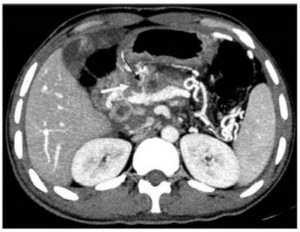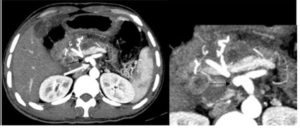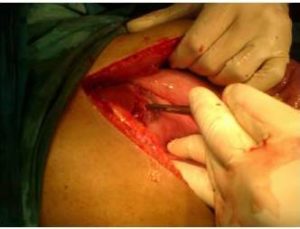Discussion
Pseudoaneurysm is an uncommon complication of chronic pancreatitis. The splenic artery is the most commonly involved artery, followed by gastroduodenal and pancreaticoduodenalarteries (Patel 2003). Rupture of pseudoaneurysm may result in either occult bleeding or massive bleeding (Kumar 2007). Massive bleeding results in increased abdominal pain. Bleeding due to pseudoaneurysm is most commonly reported in stomach/duodenum followed by peritoneal cavity, pancreatic duct, and biliary tree (Patel 2003). Haemorrhage is associated with mortality rate exceeding 50% (Weits 2002). CT scan and ultrasound usually detects the pseudoaneurysm. Arteriography is the diagnostic gold standard, which confirms the diagnosis and allows therapeutic embolization of the pseudoaneurysm (Macias 2010). Surgery is indicated in patients with bleeding and embolization failure (Macias 2010).In this case which was an emergency, we preferred surgery as the patient had features of peritonitis and he was bleeding. Also, we did not have the facility of therapeutic embolization during that time.
Pseudoaneurysm of gastroduodenal artery is a rare complication of chronic pancreatitis. Rupture of this pseudoaneurysm is a serious condition associated with high mortality. Timely management could be a life-saving measure.
Conclusion
Visceral aneurysms are rare complications of pancreatitis. Pseudoaneurysm of gastroduodenal artery is very rare, and only few cases have been reported in the literature. Rupture of this pseudoaneurysm is potentially dangerous and is associated with high mortality.
References
Chong, W. W. R., Tan, S. G. & Htoo, M. M. A. (2008). “Endovascular Treatment of Gastroduodenal Artery Aneurysm,”Asian Cardiovascular and Thoracic Annals, 16, 68-72.
Publisher – Google Scholar
Gutiérrez-Macías, A., de Garay Sanzo, M. G., Lizarralde-Palacios, E. & Martínez-Odriozola, P. (2010). “An Unusual Cause of Upper Gastrointestinal Bleeding,” Netherlands Journal of Medicine, 65(1), 42-45.
Publisher – Google Scholar
Kim, D. Y., Joo, J. K., Ryu, S. Y., Kim, Y. J., Kim, S. K. & Jung, Y. Y. (2003). “Pseudoaneurysm of Gastroduodenal Artery Following Radical Gastrectomy for Gastric Carcinoma Patients,” World Journal of Gastroenterology, 9(12), 2878-2879.
Publisher – Google Scholar
Kumar, B. & Jha, S. (2007). “Hemosuccus Pancreaticus Due to a Rupture of a Gastroduodenal Artery Pseudoaneurysm,”Hospital Physician, 61-67.
Publisher
Patel, S. B., Shah, S. R., Shah, S. S., Patel, H. B., Jain, S. & Kumar, N. A. (2003). “Pseudoaneurysm from Gastroduodenal Artery Associated with Chronic Pancreatitis: An Unusual Complication,” Indian Journal of Radiology and Imaging, 13(3), 311-313.
Publisher – Google Scholar
Weits, T. & Breumelhob, R. (2002). ‘Pseudoaneurysm of Gastroduodenal Artery Complicating Pancreatitis,’ JBR-BTR, 85, 170-171.








